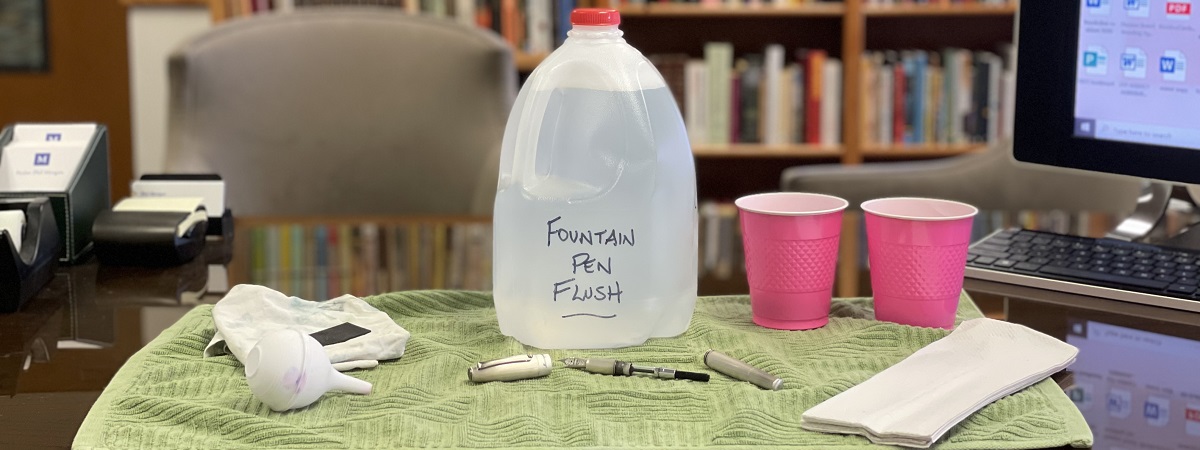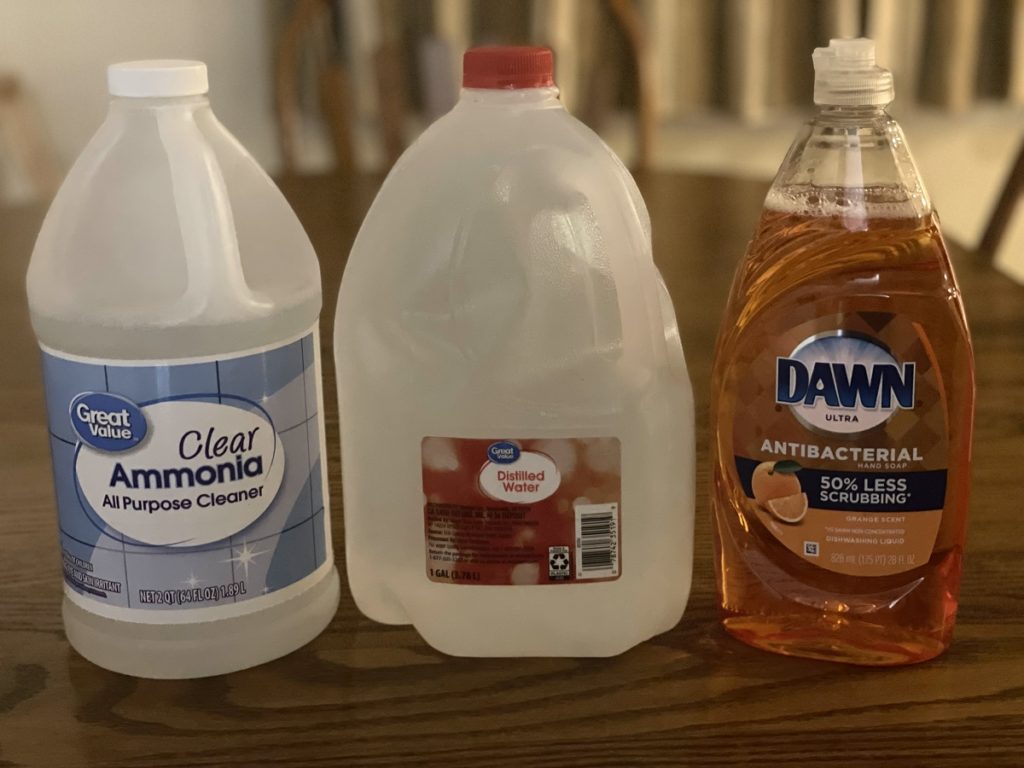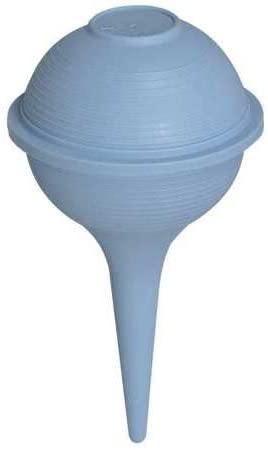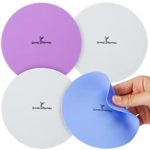
When it comes time for a deeper cleaning, buying a bottle of fountain pen flush is pricey. An 8oz bottle will run you from $11 to $18 not including shipping. OR you can just make your own. It’s very simple …
The basic recipe for fountain pen flush is one part household (5%) ammonia, added to 9 parts distilled water, with a few drops of dishwashing liquid added (“Dawn” liquid is recommended).
You can make literally gallons of this cleaning solution for just a few dollars. Read on for complete instructions, and a few extra tips about using it to clean your fountain pens.
Table of Contents
1. Always Start with Water
Water is all you actually need to clean a fountain pen, and plain tap water will do. If you love your pens, however, distilled water is cheap peace of mind that no hard or corrosive minerals will affect the components.
Sometimes, however, you’ll want to give your fountain pens a deeper clean:
- If you’ve left a pen unused with ink in the feed for a while, especially if it has dried out.
- When you change inks, and want to make sure all the old ink is completely gone (especially if you’re changing color).
- If you just haven’t done it in a while. A deeper clean occasionally is a good practice.
Always still begin with a simple water clean, and then move on to using your fountain pen flush. Here’s how you make it …
2. My Exact Fountain Pen Flush Recipe

Ingredients:
- 1.5 cups household ammonia. Check the label to make sure it says 5% ammonia. ($1.54 at Walmart for half a gallon, which is enough to make the recipe 5 times!)
- 1 gallon distilled water ($1.08 at Walmart)
- 1 ml Dawn dishwashing liquid (about 20 drops – and that is plenty)
Method: Combine all 3 ingredients and stir well, or shake gently. Store in a sealed container, clearly marked and kept out of reach of children.
It’s that simple!
3. Caution! Be Careful With Vintage Pens
I’ve read that some people have had problems using fountain pen flush on pens older than the 1960’s because the resins commonly used back then included cellulose which can be damaged by aggressive cleaning materials. I cannot confirm or disprove this, because having read the stories I’ve opted to not use anything but water on my vintage pens.
Apart from this caveat, though, I’ve never had an issue using a fountain pen flush.
4. More Water

For most of my pens, I use a bulb syringe to force water and the fountain pen flush through the nib section and out through the nib. After doing this it’s important to clean the pen thoroughly with water again to remove all the flush solution.
Assemble Your Own Fountain Pen Cleaning Kit
Most fountain pen collectors don’t sit down to clean out “a pen” — they have a cleaning session. All the pens are done at once. So, it makes sense to put together a kit you can just pull out and get to work with everything in one place.
Here are the basics I recommend:
- Bulb syringe (otherwise affectionately known by young parents as a “snot sucker”). This really is your best friend when you’re cleaning fountain pens. The secret weapon. Pick one up in the baby section at Walmart, any pharmacy, or a dollar store.
- Cotton buds. Great for swabbing the inside of nib sections, barrels and caps.
-

Rubber Jar Opener Pad Rubber jar opener pad. For getting hold of nibs when you need to remove the nib section. I cut mine down into smaller strips. [Buy on Amazon]
- Paper towel. You can never have too much. You’ll use lots of it cleaning out fountain pens.
- A cloth or rag. For polishing your pen.
- Your fountain pen flush. (See the recipe above).
There are some other great additions — especially if you’re going to do some basic maintenance / tuning as well — but those are the basic items for cleaning.
Was this post helpful? Do you have your own cleaning tips to share? Leave a comment.
Thanks for the Flush recipe. I could not justify buying an expensive bottle of the stuff from a pen company. It’s muchly appreciated.
You’re welcome!
Thanks for the information. I’d like some pics or video of nib r&r.
Is there any advantage to use a very soft, small, baby bottle type fine bristled brush on the nib and ribs from the outside?
Also, I’ve found it very hard to find replacement nibs; I use 24k gold extra fine or fine.
I don’t use any kind of brush. I just flush with solution and distilled water with some pressure supplied by the hand squeezer.
Phil
Has anyone used this cleaning solution in an ultrasonic cleaner to clean their pens? I may try it and report back. Once with distilled water; another with the cleaning solution, then a final rinse with distilled water; possibily brushing with cotton swabs after the first and second water bath?
I haven’t. Let us know!
Phil
Thanks. I have a large collection ready to start working with calligraphy. I need to clean out all my oldies. Thanks for the article…
Sitting down to clean a bunch of pens can feel like a bot of a chore, but once I get started I actually find it really relaxing. Thanks Anna.
Phil